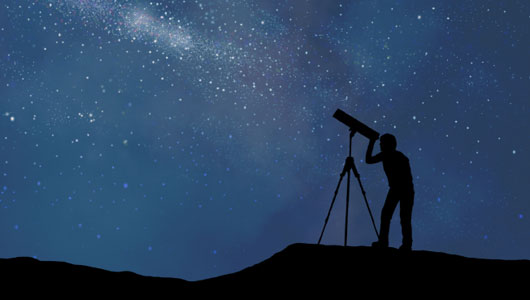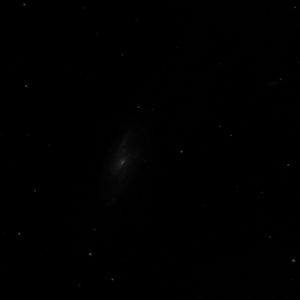 If you’ve ever looked at a bright star through a telescope, it will look much brighter and spectacular, but not contain any detail. It’s still a point of light. Much more fascinating and challenging is to focus your telescope on deep-sky objects such as star clusters, nebulae and galaxies. Many of these can be seen through any reasonable small telescope.
If you’ve ever looked at a bright star through a telescope, it will look much brighter and spectacular, but not contain any detail. It’s still a point of light. Much more fascinating and challenging is to focus your telescope on deep-sky objects such as star clusters, nebulae and galaxies. Many of these can be seen through any reasonable small telescope.
But on first sight the galaxy or nebulae you’ve chosen may be unimpressive, just a sort of indistinct, grey cloud with only a few lonely stars visible, like oases in a desert. The problem is the human eye’s inability to see well at night. It can be very disappointing to see such brilliant, colorful images in astronomy books and magazines, and then observe very little through the telescope.
But telescopes can assist in providing a better show. Unlike terrestrial viewing, or observing the planets, with deep-sky objects the purpose of the telescope isn’t to magnify detail. Instead you want it to gather a lot of light to assist your poor, weak eyes. The reason you can’t see many deep-sky objects with the naked eye isn’t because they are too small – it’s because they are too dim.
The major problem is light pollution, especially the very bright city lights. So try to get away from the city if you can – it’s also great to get away from the rat race for a while! The clearest part of the night sky is directly above you away from air pollution. Also many houses turn off their lights around midnight. Don’t observe near office buildings – they often leave their lights on all night. Try to pick nights after days with low air pollution. Also try your deep-sky observing when the Moon isn’t in the sky. Some deep-sky objects, such as the Orion Nebula (M42), can be seen faintly through heavy light pollution, but seen in really dark conditions, they will always look much more impressive and show more detail.
You need to take time to allow your eyes to adjust to the dark, which can take many minutes. Your pupils expand almost immediately, but to see optimally in the dark, certain chemical changes have to take place in your retinas. After 15 minutes you aren’t close to full adaptation; in the next 15 minutes you are about 6 times better adapted. This is probably good enough but the adaptation does continue to rise gradually for more than 90 minutes. A good idea is to spend 30 minutes studying planets and stars, and then try the deep-sky objects.
You cannot do deep-sky observing in complete darkness. The cone cells in your eyes allow you to see color but they need more light than the rods that see in black and white. This is why you can’t see color in a dimly-lit room. But you don’t need much light for observing. You can get a good result by placing red paper over the front of a torch secured with a rubber band. But a red LED flashlight is much more effective; there are specific ones available for astronomers.
You can also observe with one eye and look at your charts with the other. Put an eye-patch over the observing one when not in use. There is a region of your retina, called the fovea centralis, which is packed with cone cells, but these aren’t effective in dim light. This means you need to look at your image slightly off center. Try to focus your eyes slightly away from the image. This is called averted vision, and you will need to do it whenever you are doing deep-sky observing. In fact your eyes are most sensitive to images located 8-16° from the center of vision going towards your nose. 6-12° above your head is almost as good. Experiment and see what benefits you. Don’t avert too much or you won’t get good resolution. But if you want to see color clearly then look right at the image, because of the number of cones at the fovea.
We’ve all seen things out of the corner of our eye. This is because our peripheral vision is very sensitive. Under particular atmospheric conditions, if you jiggle the telescope about, a deep-sky object may suddenly become visible. But sometimes keeping absolutely still for a long period of time will get the right result.
It is commonly thought low magnification on telescopes is best for deep-sky observing, but the reverse is actually true. This is because the eye loses the power of resolution in dim light. It’s like looking at a book in dim light. You can still make out the print on the page, but you can’t read it because you can’t resolve the words. The eye is able to resolve detail almost down to 1 arcminute in bright illumination, but can only do so at around 20-30 arcminutes wide in dim light. This means that to resolve detail in a very faint object the image will need to be magnified to around 30 arcminutes across. But it’s best to experiment with different magnifications to find the best one for the object you are observing.



